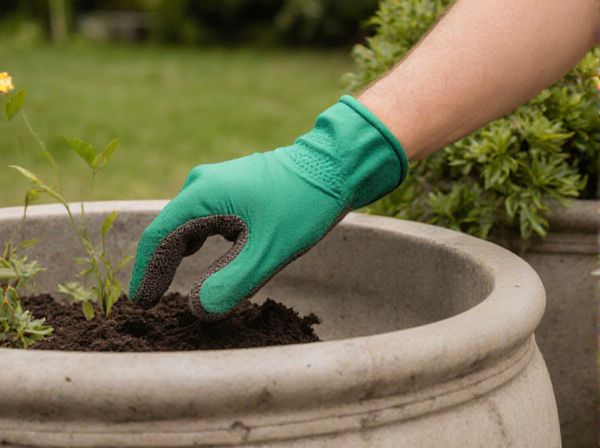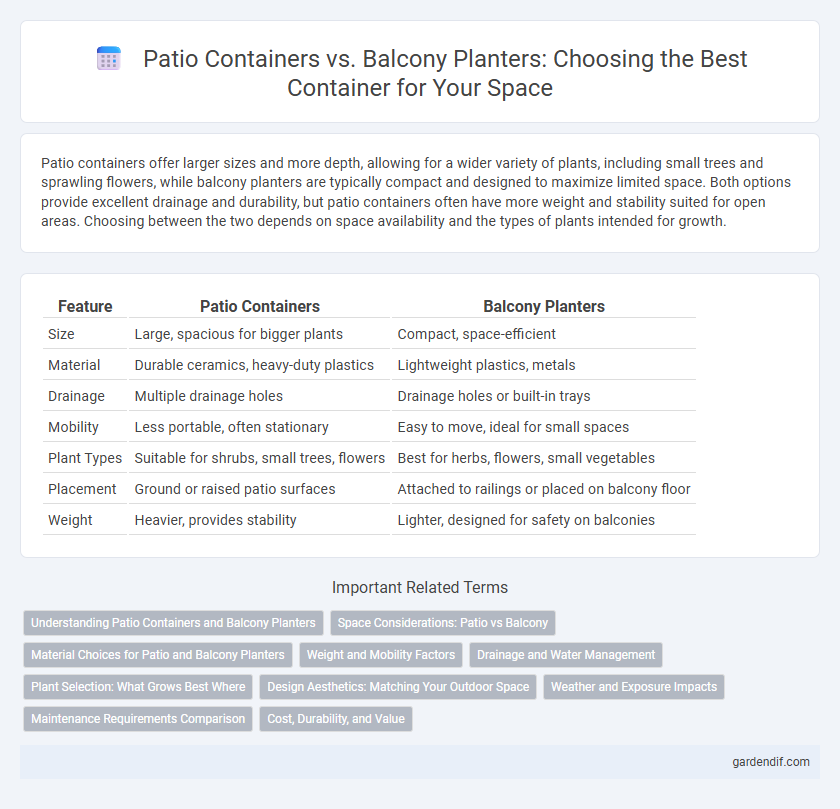
Patio containers vs balcony planters Illustration
Patio containers offer larger sizes and more depth, allowing for a wider variety of plants, including small trees and sprawling flowers, while balcony planters are typically compact and designed to maximize limited space. Both options provide excellent drainage and durability, but patio containers often have more weight and stability suited for open areas. Choosing between the two depends on space availability and the types of plants intended for growth.
Table of Comparison
| Feature | Patio Containers | Balcony Planters |
|---|---|---|
| Size | Large, spacious for bigger plants | Compact, space-efficient |
| Material | Durable ceramics, heavy-duty plastics | Lightweight plastics, metals |
| Drainage | Multiple drainage holes | Drainage holes or built-in trays |
| Mobility | Less portable, often stationary | Easy to move, ideal for small spaces |
| Plant Types | Suitable for shrubs, small trees, flowers | Best for herbs, flowers, small vegetables |
| Placement | Ground or raised patio surfaces | Attached to railings or placed on balcony floor |
| Weight | Heavier, provides stability | Lighter, designed for safety on balconies |
Understanding Patio Containers and Balcony Planters
Patio containers are typically larger, designed to accommodate a variety of plants and provide flexibility in garden layout, making them ideal for spacious outdoor areas. Balcony planters are compact and tailored for limited spaces, featuring secure attachments to railings for safety and maximizing vertical gardening potential. Selecting the right option depends on the available space, plant type, and desired aesthetic for either patios or balconies.
Space Considerations: Patio vs Balcony
Patio containers offer more flexibility in size and placement due to typically larger floor space, allowing for a wider variety of plants and arrangements. Balcony planters are generally more compact and require secure mounting options to optimize limited space and ensure safety. Understanding the spatial constraints of each area is essential for selecting appropriate containers that maximize plant health and aesthetic appeal.
Material Choices for Patio and Balcony Planters
Patio containers often utilize durable materials like terra cotta, ceramic, and fiberglass to withstand outdoor elements and provide excellent insulation for plant roots. Balcony planters frequently feature lighter materials such as plastic, resin, or lightweight metals to accommodate limited space and ease of mounting on railings. Choosing the right material impacts drainage, weight, and maintenance, enhancing plant health and container longevity in both settings.
Weight and Mobility Factors
Patio containers are typically larger and heavier, offering increased stability for bigger plants but limiting easy relocation due to their substantial weight. Balcony planters are designed to be lightweight and compact, facilitating mobility and fitment in confined spaces while maintaining structural support for smaller plants. Choosing between them depends on balancing the need for portability against the desired plant size and container stability.
Drainage and Water Management
Patio containers typically offer enhanced drainage systems with multiple drainage holes and built-in water reservoirs, preventing root rot in larger plants. Balcony planters often feature limited drainage options, requiring careful monitoring of water levels to avoid waterlogging in compact spaces. Effective water management in both container types ensures healthy plant growth by balancing moisture retention and preventing excess water accumulation.
Plant Selection: What Grows Best Where
Patio containers support larger, sun-loving plants such as tomatoes, peppers, and ornamental grasses due to their spacious roots and better sunlight exposure. Balcony planters are ideal for smaller herbs, shade-tolerant flowers, and compact vegetables like lettuce and radishes that thrive in limited space and partial shade. Understanding these growth requirements ensures optimal plant health and maximizes container gardening success.
Design Aesthetics: Matching Your Outdoor Space
Patio containers often feature larger, more versatile designs that complement open outdoor spaces by adding bold accents or lush greenery, enhancing overall ambiance with customizable shapes and materials. Balcony planters prioritize compact and space-efficient aesthetics, designed to seamlessly fit railings or narrow ledges while maximizing visual appeal in limited areas. Selecting container styles that harmonize with architectural elements and color schemes ensures cohesive design aesthetics tailored to either spacious patios or confined balconies.
Weather and Exposure Impacts
Patio containers typically experience more direct sunlight and prolonged exposure to weather elements such as rain and wind, requiring plants that tolerate strong light and variable moisture. Balcony planters often face limited space and partial shade, with exposure varying based on building orientation, necessitating containers with efficient drainage and weather-resistant materials. Selecting the right container ensures optimal plant health by balancing sun exposure, moisture retention, and protection from harsh weather conditions.
Maintenance Requirements Comparison
Patio containers typically require less frequent watering due to their larger soil volume, which retains moisture longer compared to balcony planters. Balcony planters need more regular attention to prevent drying out and often require lighter, more frequent fertilization to support plant growth in limited soil. Both container types benefit from routine inspection for drainage issues and pest control to maintain plant health efficiently.
Cost, Durability, and Value
Patio containers typically offer greater durability than balcony planters due to sturdier materials like resin or metal, justifying a higher initial cost with long-term value. Balcony planters tend to be more affordable and lightweight, making them ideal for smaller spaces but may require more frequent replacement. Investing in quality patio containers enhances outdoor aesthetics and plant health, delivering better overall value despite the upfront expense.
Patio containers vs balcony planters Infographic

 gardendif.com
gardendif.com